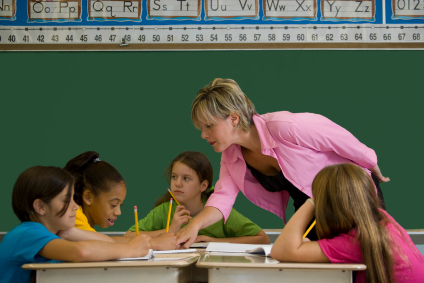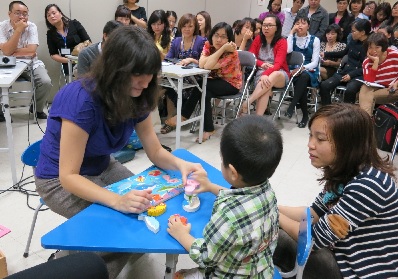Applied Behavior Analysis
Definition/Description: Applied Behavior Analysis (ABA) is defined as the process of systematically applying behavioral principles of learning to improve socially significant behaviors and increasing or decreasing targeted behaviors. Its purpose is to teach students, especially those with Autism, the skills they need to learn from their environment. We use this to detriment what skills students need to help be successful in school as well and in their society. Students work on their behavior so they can get the reward.
|
In this video the teacher and the student work on both reading and writing. The video demonstrated how using applied behavior analysis helps the student with autism focus and complete the assignment.
|
Justification: "A number of completed studies have demonstrated that ABA techniques can produce improvements in communication, social relationships, play, self care, school and employment. These studies involved age groups ranging from preschoolers to adults. Results for all age groups showed that ABA increased participation in family and community activities" (Olive, 2015). Students with Autism or students with behavior issues often have a hard time socializing and participation in social communication. "Many of the social interaction problems that individuals with autism exhibit involve deficits in social repressiveness" (Hallahan, Kauffman,and Pullen, 2015). Parents often notice this when children are young and as they get older they see and experience the difficulties of having their children in public. That is why it is important that we not only work on student academics in school but also their social behaviors as well. Often times students with ASD have a lack of communication or are afraid of how their peers might react. that is also another reason why using Applied Behavior Analysis is important in helping these student with autism work on their social interactions to allow them to be apart of the class and cooperate with their peers (Hallahan, Kauffman,and Pullen, 2015).
|
|
Example: My mom is a special Education teachers and this is on of her main focuses for students with Autism. She said, "When students with Autism can have visual representation and are held responsible for their learning they want to do it. She rewards her students using golden tokens and gives them feedback on how well they did and why. Just like the example below.
Example:
"A cue is given —› the child responds —› a reward is given for a correct response (Sd) —› (R) —› (Sr) The cue, referred to as a discriminative stimulus (Sd), is a specific environmental event or condition in response to which a child is expected to exhibit a particular behavior. What this looks like in everyday life is this: Child 1: Hi! —› (Sd) Student: Hi. —› (R) Child 1: [smiles] C’mon! Let’s go! —› (Sr)" (Olive, 2015). |
|
This picture is showing a teacher helping a student with autism remember the objects and colors.
|
Individual Student:
For students with Autism. this technique allows them to work on skills they need in school as well as in society, but it provides them with a reward and something to word towards. Even though the Autism spectrum is so wide, this strategy will still help all students with autism, as well as even a whole class. The student I has last semester with Autism often got discouraged in the main stream classroom when he couldn't get something. The para would often tell him he had to do it or go to the SPED room. If he was doing this strategy he would them have the reinforcement needed and support as well as something to word towards. |
"Behavior analysis is a scientifically validated approach to understanding behavior and how it is affected by the environment. In this context, “behavior" refers to actions and skills. "Environment" includes any influence – physical or social – that might change or be changed by one's behavior" (Autism Speaks, 2015).
|
Content Area:
This can be used in any classroom, in a modified form. The teacher when possible can work with students one on one and track their progress. They can get rewards that are within the class. Usually however this is a strategy that is used one-on-one with a Special Education teacher or Therapist. As demonstrated in the video above it can be done in reading and math as well as any other content area. It is all about rewarding them for their work. Examples of Rewards:
|
This video demonstrates how this strategy allows student to work on everyday skills, such as how to count money, how to behave in public, etc.
|
References:
Applied Behavior Analysis (2015). Autism Speaks Inc. Retrieved from https://www.autismspeaks.org/what-autism/treatment/applied-behavior-analysis-aba
Applied Behavior Analysis (2015). Autism Speaks Inc. [image]. Retrieved from https://www.autismspeaks.org/what-autism/treatment/applied-behavior-analysis-aba
Hallahan, D. P., Kauffman, J. M., & Pullen, P. C. (2015). Exceptional learners: An introduction to special education. Boston, MA: Pearson/Allyn & Bacon.
How to teach a child with Autism using ABA techniques (2011). [Web video]. Retrieved form https://www.youtube.com/watch?v=Edjxwj0ib00
Olive, M. (2015). Applied Behavioral Strategies. Retrieved from http://www.appliedbehavioralstrategies.com/basics-of-aba.html
Olive, M. (2015). Applied Behavioral Strategies. Retrieved from http://www.appliedbehavioralstrategies.com/basics-of-aba.html
Applied Behavior Analysis (2015). Autism Speaks Inc. Retrieved from https://www.autismspeaks.org/what-autism/treatment/applied-behavior-analysis-aba
Applied Behavior Analysis (2015). Autism Speaks Inc. [image]. Retrieved from https://www.autismspeaks.org/what-autism/treatment/applied-behavior-analysis-aba
Hallahan, D. P., Kauffman, J. M., & Pullen, P. C. (2015). Exceptional learners: An introduction to special education. Boston, MA: Pearson/Allyn & Bacon.
How to teach a child with Autism using ABA techniques (2011). [Web video]. Retrieved form https://www.youtube.com/watch?v=Edjxwj0ib00
Olive, M. (2015). Applied Behavioral Strategies. Retrieved from http://www.appliedbehavioralstrategies.com/basics-of-aba.html
Olive, M. (2015). Applied Behavioral Strategies. Retrieved from http://www.appliedbehavioralstrategies.com/basics-of-aba.html


